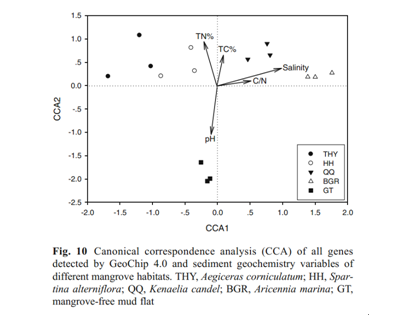Shijie Bai, Jiangwei
Li, Zhili He,Joy D. Van Nostrand, Yun Tian, Guanghui Lin, Jizhong Zhou,
Tianling Zheng,Appl Microbiol Biotechnol,2013, 97:7035– 7048
Mangroves are unique and highly productive
ecosystems and harbor very special microbial communities. Although the
phylogenetic diversity of sediment microbial communities of mangrove habitats
has been examined extensively, little is known regarding their functional gene
diversity and metabolic potential. In this study, a high-throughput functional
gene array (GeoChip 4.0) was used to analyze the functional diversity,
composition, structure, and metabolic potential of microbial communities in
mangrove habitats from mangrove national nature reserves in China. GeoChip data
indicated that these microbial communities were functionally diverse as measured
by the number of genes detected, unique genes, and various diversity indices.
Almost all key functional gene categories targeted by GeoChip 4.0 were detected
in the mangrove microbial communities, including carbon (C) fixation, C
degradation, methane generation, nitrogen (N) fixation, nitrification,
denitrification, ammonification, N reduction, sulfur (S) metabolism, metal
resistance, antibiotic resistance, and organic contaminant degradation.
Detrended correspondence analysis (DCA) of all detected genes showed thatSpartina
alterniflora(HH), an invasive species, did not harbor significantly
different microbial communities fromAegiceras corniculatum(THY), a
native species, but did differ from other species,Kenaelia candel(QQ),Aricennia marina(BGR), and mangrove-free mud flat (GT). Canonical
correspondence analysis (CCA) results indicated the microbial community
structure was largely shaped by surrounding environmental variables, such as
total nitrogen (TN), total carbon (TC), pH, C/N ratio, and especially salinity.
This study presents a comprehensive survey of functional gene diversity of soil
microbial communities from different mangrove habitats/species and provides new
insights into our understanding of the functional potential of microbial communities
in mangrove ecosystems.

返回

